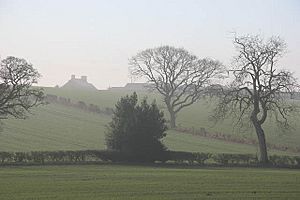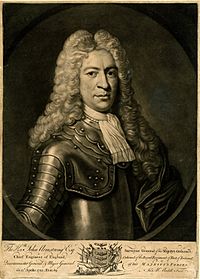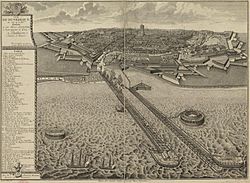Thomas Lascelles (engineer) facts for kids
Quick facts for kids
Thomas Lascelles
|
|
|---|---|

Landscape near Ganthorpe, Lascelles' birthplace
|
|
| Born | 1 May 1670 Ganthorpe, Terrington, North Yorkshire |
| Died | 1 November 1751 (aged 81) Pontefract, Yorkshire |
| Allegiance | |
| Service/ |
Engineer |
| Years of service | 1689–1750 |
| Rank | Colonel |
| Commands held | Chief Royal Engineer and Surveyor-General of the Ordnance, April 1742 |
| Battles/wars | Williamite War in Ireland 1689-1691 Battle of the Boyne War of the Spanish Succession 1701-1714 Cadiz 1702 Battle of Blenheim 1704 1715 Jacobite Rising |
| Relations | Lieutenant-General Peregrine Lascelles (1685-1772) |
| Signature |  |
Thomas Lascelles (born around 1670 – died November 1, 1751) was a British military engineer. He was an expert in military equipment and held many important jobs between 1713 and 1750.
His roles included overseeing the destruction of port facilities at Dunkirk from 1713 to 1733. He also served as the Chief Royal Engineer and Surveyor-General of the Ordnance from 1742 to 1750.
Life Story
The Lascelles family was a large group involved in trade. They had connections in London, Ireland, New England, and Barbados. They also had family branches across Yorkshire.
It can be tricky to trace individual family members. This is because they often used the same first names. Names like Thomas, Francis, and William were very common.
Thomas Lascelles came from a smaller part of the family. They owned land in Ganthorpe, near Terrington. He was born in May 1670. He was the oldest son of Thomas Lascelles (1634-1706) and Maria Moorwood.
He had two brothers who lived to adulthood. Francis (1672-1753) became a vicar in Knottingley, Yorkshire. His other brother, William, died in battle at Mons in 1709. Thomas also had three sisters: Maria, Elizabeth, and Sarah.
It seems Thomas Lascelles never married. When he died, he left a large sum of money, about £10,000. He also left his land at Hunton and Scotton to his younger brother, Francis.
Military Career

Thomas Lascelles joined the army as a volunteer in 1689. This was during the Williamite War in Ireland (1689-1691). It was here that he first met John Armstrong. They became professional colleagues and friends for many years.
Lascelles fought in the Battle of the Boyne in 1690. After the war ended in 1691, he moved to Flanders. There, he took part in the Nine Years War.
When the War of the Spanish Succession began in 1702, he and Armstrong joined the Duke of Ormonde's Horse Guards. They fought at Cadiz. In 1704, Lascelles became a Captain in Owen Wynne's Regiment of Foot. He also received extra pay as an engineer, which he shared with Armstrong.
Both men fought in Marlborough's campaigns in Flanders. Lascelles was badly hurt at the Battle of Blenheim in 1704. He received money from a fund set up by Queen Anne for soldiers in Churchill's army.
When the war ended in 1713, Wynne's Regiment was disbanded. Lascelles was put on "half-pay," meaning he received half his usual salary. As part of the Peace of Utrecht treaty, France agreed to destroy the defenses of Dunkirk. They also had to block its port and demolish the water gates. These structures were not allowed to be rebuilt.
Dunkirk was a major base for privateers, who were like legal pirates. They would attack British merchant ships. It was easy for them to reach the North Sea quickly and avoid British patrols. Because of this, destroying Dunkirk was a very important task for Britain. In September 1713, Lascelles and Armstrong were chosen to oversee this work.
Lascelles was called back to Britain for a short time during the Jacobite Rising of 1715. For his service, he was given an honorary title in Glasgow. Many others, including his relative Peregrine Lascelles, also received this title.
He returned to Dunkirk in 1718, taking over from Armstrong as Deputy Quartermaster General. The people of Dunkirk strongly resisted the destruction of their port. This made the job even harder, adding political problems to the complex engineering work. Lascelles also served as temporary Director of Engineers from 1720 to 1722. He was also deputy Surveyor-General of the Ordnance when Armstrong was away. By the time he returned to England in 1725, he was very tired.
In the following years, new piers and port facilities were built at Dunkirk. The French government now wanted to rebuild its navy in Northern France. Lascelles went back to Dunkirk in 1730. However, by 1733, it was clear that his mission to destroy the port was impossible.
At the start of the War of the Austrian Succession in 1740, he was asked to join the Cartagena Expedition. But his duties in England made this impossible. His request to lead a regiment was also turned down.
When Armstrong died in July 1742, Lascelles took over as Chief Royal Engineer. He was also deputy to the Lieutenant-General of the Ordnance. In 1744, he visited the important port of Ostend to check its defenses. As Inspector-General of Artillery, he took part in talks between Britain and the Dutch Republic. These talks were about continuing the war in Flanders.
The French won the Battle of Fontenoy in June 1745. They then captured Ostend in August. By 1747, they controlled most of the Austrian Netherlands.
While France was winning on land, Britain was winning at sea. The war ended with the Treaty of Aix-la-Chapelle in 1748. Lascelles left his jobs on March 1, 1750. The next month, he was given a yearly pension of £200 for the rest of his life. He moved back to Pontefract in Yorkshire, where he died on November 1, 1751.
Succession
| Military offices | ||
|---|---|---|
| Preceded by John Armstrong |
Chief Royal Engineer 1742–1751 |
Succeeded by William Skinner (in 1757) |
| Preceded by John Armstrong |
Surveyor-General of the Ordnance 1742–1750 |
Succeeded by Charles Frederick |


